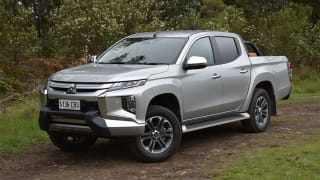
Mitsubishi Triton 2020 review: GLS Premium GVM test
We recently spent a working week in Mitsubishi's stylish premium-grade Triton to see how it measures up in the premium ute market.
Browse over 9,000 car reviews
They say good things come to those who wait, and perhaps this is the best demonstration of that truism… in the automotive world, that is.
Aussies have asked for it for years, and Volkswagen has finally delivered. Yep, the Amarok is available with a V6 engine and a manual gearbox!
Now, we all know the Amarok has made waves since it became available with a bent six, but that didn’t stop some people from asking, ‘What if it came with a clutch pedal?’
Years later, they don’t need to wonder anymore. Let’s get shifting.
| Volkswagen Amarok 2020: TDI500 V6 Core 4Motion | |
|---|---|
| Safety rating | |
| Engine Type | 3.0L turbo |
| Fuel Type | Diesel |
| Fuel Efficiency | 9.7L/100km |
| Seating | 5 seats |
| Price from | $29,920 |
The Amarok might be nudging its 10th year in market, but it’s still a boxy but muscular looker, which is something you can’t say about many dual-cab pick-ups.
Picking the manual out from the Amarok V6 crowd is a little tough, though. Trainspotters will notice its 17-inch 'Posadas' alloy wheels, and let’s not forget its rims are shared with its automatic entry-level counterpart. Either way, that’s it.
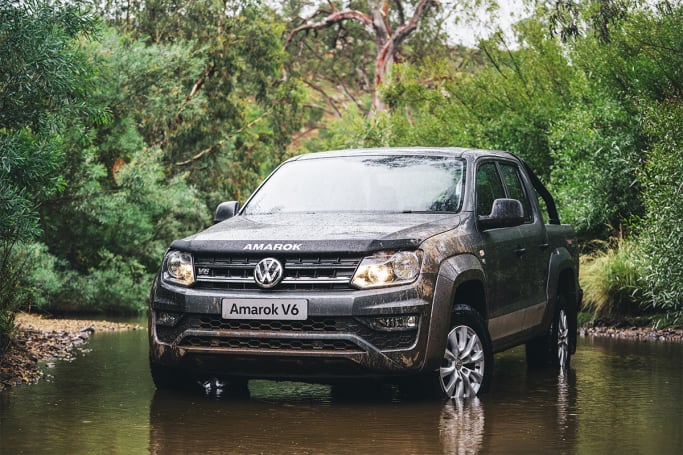
Okay, there is more to it than just that. Buyers can add the no-cost 'Enduro' options package, which bundles in a bonnet protector, black side decals and a black sports bar. And why wouldn’t you tick that box? We would, if signwriting wasn't on the agenda.
Despite the drivetrain change, dimensions are the same as any Amarok V6, measuring 5254mm long (with a 3095mm wheelbase), 1954mm wide and 1834mm tall.
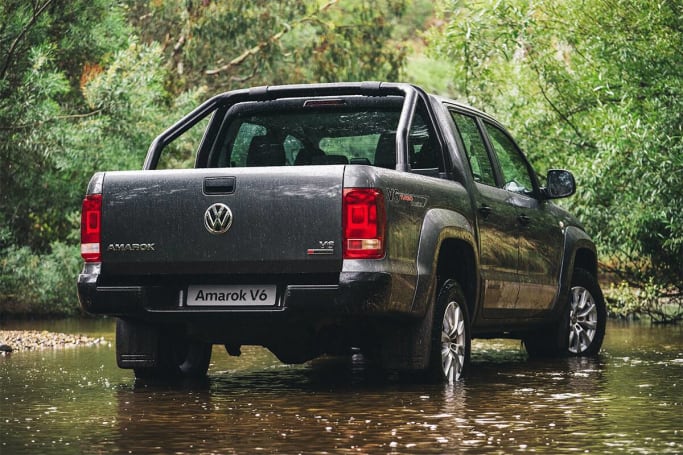
Inside, heavy-duty rubber floor coverings and hard-wearing cloth upholstery are giveaways you’re dealing with an entry-level Amarok V6, ready to work hard.
Indeed, the manual Amarok V6 is a rough and tough ute, so you won’t find much in the way of luxurious finishes. Granted, its steering wheel, gearshift and central armrest are trimmed in leather, but hard plastics abound for most other major touchpoints.
The cabin is well-designed, with plenty of space for loose items (see the cut-out in the middle of the dashboard and the cubby hole in front of the gearshift), and then there’s the more secure glove box and central storage bin, both of which are decently sized.
A pair of cupholders is predictably located between the front seats, while all four door bins are large enough to house drink bottles. There isn’t a flip-down rear armrest with cupholders in the second row, though.
Once a class leader, the multimedia system looks and feels old in 2020. It doesn’t help that it powers a 6.33-inch touchscreen, which is very small these days.
That said, you do get Apple CarPlay and Android Auto support, so just plug and play. And you’ll want to because there’s no in-built satellite navigation here. Again, this is an entry-level Amarok V6.
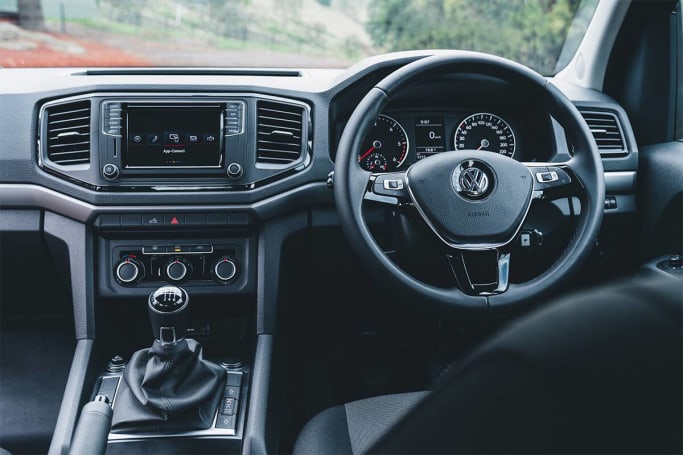
The first row features a 12-volt power outlet, a USB port and an auxiliary input, while the second row misses out on all three.
Don’t expect a lot of legroom in the rear. Behind my 184cm driving position, my knees brush up against the front backrests (which have map pockets). That said, the Amarok V6’s width means there’s more than enough shoulder room, even with three adults abreast.
Three top tether and two ISOFIX anchorage points are on hand for installing child seats, making the Amarok V6 a viable option for parents, although the lack of rear air vents might prompt complaints from the smaller members of he family.
And being a dual cab pick-up, you can expect a large tub. In this instance, it measures 1555mm long, 1620mm wide (including 1222mm between the wheelarches, which is enough width to accommodate a standard Australian pallet) and 508mm tall.
Priced from $49,590, before on-road costs, the manual Amarok V6 appears pricey. But when you consider it’s the most affordable way into a V6 dual cab pick-up in this market, it starts to make a lot more sense.
In fact, all of its rivals in the same price range (Toyota HiLux, Ford Ranger, Mitsubishi Triton, et al) make do with four-cylinder engines that fall well short of it in the power and torque stakes, but more on that in the next section of this review.
The manual Amarok is only offered in one entry-level specification, dubbed Core. For the spend you get a part-time transfer case with low range, a rear mechanical differential lock, underbody protection, fender flares, ventilated disc brakes, mud flaps, power-adjustable side mirrors (with heating), power-operated windows, a full-size steel spare wheel and a matt-black rear step bumper.
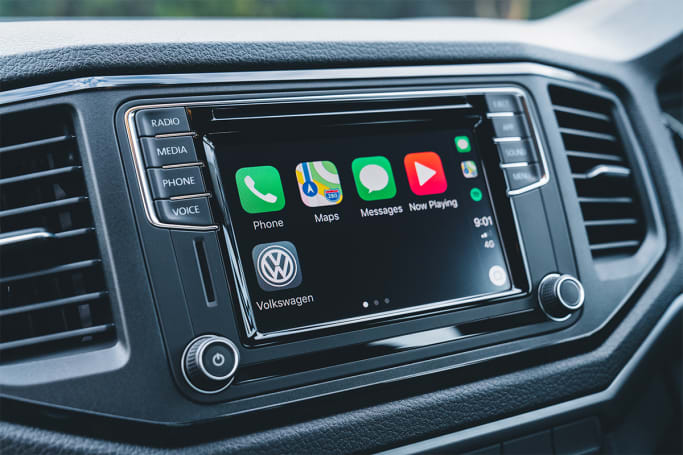
Inside, a six-speaker sound system, a monochrome multi-function display and single-zone air-conditioning feature.
Auto headlights and rain-sensing wipers are extra-cost options alongside the six paintwork options: 'Candy White', 'Mojave Beige', 'Indium Grey', 'Reflex Silver', 'Starlight Blue' and 'Deep Black').
As you’d expect, there’s also a plethora of dealer-fit accessories available.
Just like many hoped, the ubiquitous 3.0-litre turbo-diesel V6 engine remains under the Amarok’s bonnet but is now mated to a six-speed manual gearbox.
That said, the three-pedal set-up does have one key downside: a 50Nm loss in maximum torque. Indeed, the manual version produces 500Nm from 1250-3000rpm, instead of its automatic counterpart’s 550Nm from 1500-2500rpm.
And while peak power is shared, at 165kW, the manual develops it over a narrower band (3250-4500rpm versus 2500-4500rpm in the automatic), so there’s also that.
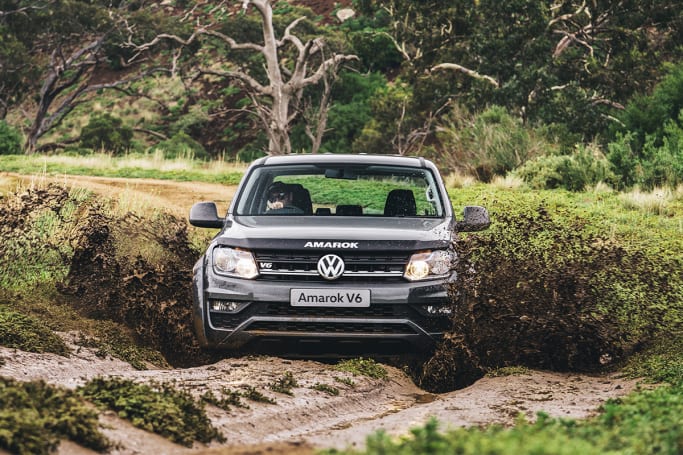
Either way, you get up to 180kW on overboost, which is available for 10 seconds when the accelerator is depressed beyond 70 per cent in third or fourth gear, making it ideal for highway overtaking.
So, when it comes to outright grunt, the manual Amarok V6 still blows the competition away, so there’s not much to be upset about here.
Maximum braked towing capacity is also down in the manual, at 3000kg, instead of the automatic’s 3500kg. That said, the former does have the biggest maximum payload of any Amarok V6, at 1004kg, which makes it a genuine one-tonner.
For reference, the manual Amarok V6’s maximum unbraked towing capacity is 750kg, while its towbar load limit is 300kg.
The manual Amarok V6’s claimed fuel consumption on the combined cycle test (ADR 81/02) is 9.7 litres per 100 kilometres, which is 0.7L/100km more than its automatic counterpart drinks.
During our launch drive, consisting mainly of highway driving and off-roading, we averaged a little less, at 9.4L/100km, but expect that figure to climb above 10.0L/100km in mixed usage.
For reference, fuel tank capacity is 80 litres. There’s also a second tank that stores up to 13.0L of the required AdBlue.
Carbon dioxide emissions are claimed to be 254 grams per kilometre, meaning the manual chugs out 18g/km more CO2 than the auto.
The Amarok range was awarded a five-star ANCAP safety rating way back in 2011, but a lot has changed in the nine years since.
For example, while you get dual front and front-side airbags, you don’t get curtain airbags for the second row, making rear occupants more vulnerable in crashes.
Then there’s the lack of advanced driver-assist systems, such as autonomous emergency braking, lane-keep assist, blind-spot monitoring and cross-traffic alert.
These active safety features can be had in many of the Amarok’s rivals, albeit to varying degrees.
You do, however, get cruise control (not adaptive), a reversing camera, rear parking sensors, hill-start assist and hill-descent control as well as the usual electronic stability and traction control systems, with the former even accounting for trailer sway.
Basic Warranty
5 years / unlimited km warranty
ANCAP Safety Rating

The Amarok range comes with Volkswagen’s five-year/unlimited-kilometre warranty, which is on par with most of the mainstream brands. Some (we’re looking at you, Kia and SsangYong) up the ante to seven years.
One year of roadside assistance is also included with the ute.
Also on par are the service intervals, which are every 12 months or 15,000km, whichever comes first. What isn’t, though, is their cost.
Even with a five-year/75,000km capped-price servicing plan, the average charge per visit is $609. Needless to say, that’s pretty pricey.
When it comes to sheer driving pleasure, the Amarok V6 sets the standard for utes.
Part of that success is thanks to its previously exclusive automatic transmission, and at long last we’re happy to report its manual counterpart is just as good.
Sure, first gear is short, but the engine produces peak torque just above idle, so it’s easy to come off the line in second if you want/need to, especially when low-range is engaged. But more on off-roading in a moment.
Conversely, the throw is relatively short, which is nice, while the gate is surprisingly smooth – two key characteristics of a good manual transmission.
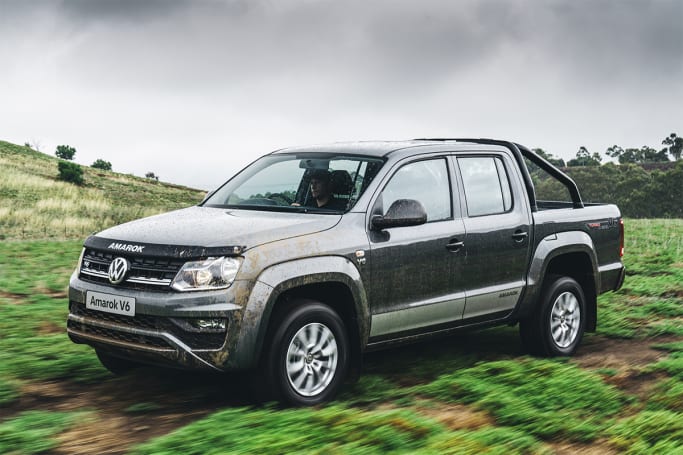
Even better, though, is the clutch, which is well-weighted. Indeed, in a world where most manual utes feel suitably agricultural, the Amarok V6 does its best impression of a sports car.
Naturally, the V6 helps matters by being the perfect dancing partner. You hardly notice the manual’s aforementioned torque deficit because there’s still so much to play with.
And a brief moment after maximum torque departs, peak power arrives and pushes you towards the redline. Yep, this is an engine that doesn’t really run out of puff.
Now, there’s much more to this Amarok V6’s story than just its manual gearbox. As mentioned, it also ushers in a transfer case that plays a key role in its part-time four-wheel drive system with low-range – a first for Volkswagen’s hardest-hitting ute.

Yep, if you want rear-wheel drive antics (and better fuel efficiency), they’re possible by leaving the manual in 2H. If you want unflappable AWD grip, switch it over to 4H by engaging neutral and pressing one button.
But if you need the capability of low-range to get you out of a sticky situation, press that button one more time and 4L arrives to save the day. And if that’s not enough, there’s still a rear mechanical differential lock on hand, as in the automatic.
Needless to say, our off-road expedition proved this set-up works really well. Again, a lot of this Amarok’s success can be put down to its mighty V6 engine, which serves up more than enough torque to get the job done. Capable, indeed.
But credit should also be sent the way of the 'Off Road' drive mode, which slackens off the ABS and ESP to make braking and accelerating more off-road-friendly, but only in 2H and 4H, of course.
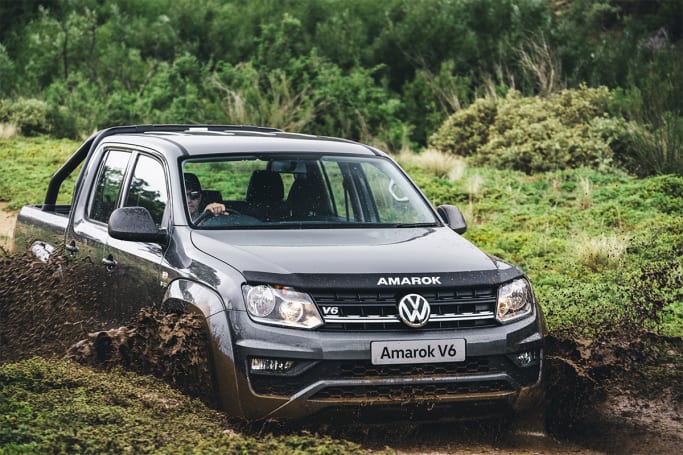
The version of hill-descent control employed here is also brilliant, automatically engaging when tackling a steep decline, with its speed adjusted by the accelerator and brake pedals, instead of buttons on the steering wheel, which can feel unnatural.
Off- and on-road performance is helped by the Amarok V6’s hydraulic power steering, which is a brilliant throwback to the time before the electric revolution. As such, feel is one of its strong points.
The steering is weighty but not heavy, making it great in hand. That said, it is a tad hefty at low speed, and a 12.9m turning circle isn’t exactly tight, but we’re talking about a ute after all.
Suspension-wise, the Amarok V6 and its ladder-frame chassis have double wishbones up front and leaf springs at the rear, the latter dealing with an unladen tub better than you might think. Yep, there’s very little skittishness going on here.
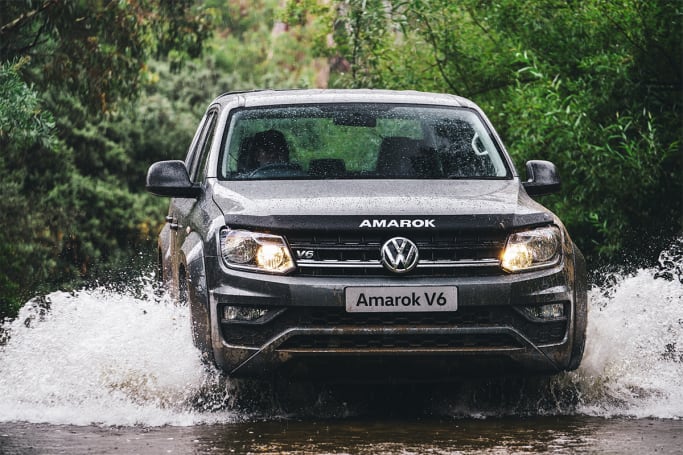
Generally speaking, lumps and bumps are dealt with well on road, while the ride is just as settled off-road. This is a ute that doesn’t feel like a ute – and that’s a good thing.
Speaking of which, the way in which the manual Amarok V6 shifts its 2076kg frame is remarkable. Sure, it can’t defy physics, but it exudes relative composure when being pushed around a corner with intent.
Can you believe Australia is the only market in the world that gets access to the manual Amarok V6? Given how good the automatic version is, it should come as no surprise that the manual adheres to the same high standard.
Yes, the Amarok V6 is getting a little long in the tooth, and that means it falls well short on the safety and multimedia fronts, but it’s still the best drive in the ute segment. Needless to say, those Aussies that cried out for a manual version have been rewarded for their patience.
Is the manual Amarok V6 the best dual-cab pick-up on the market? Tell us what you think in the comments below.
Note: CarsGuide attended this event as a guest of the manufacturer, with travel and meals provided.
| Vehicle | Specs | Price* | |
|---|---|---|---|
| TDI420 Core 4Motion (4X4) | 2.0L, Diesel, 8 SP AUTO | $39,600 – 46,530 | 2020 Volkswagen Amarok 2020 TDI420 Core 4Motion (4X4) Pricing and Specs |
| TDI420 (4X2) | 2.0L, Diesel, 8 SP AUTO | $28,380 – 34,210 | 2020 Volkswagen Amarok 2020 TDI420 (4X2) Pricing and Specs |
| TDI400 Core 4Motion (4X4) | 2.0L, Diesel, 6 SP MAN | $33,220 – 39,600 | 2020 Volkswagen Amarok 2020 TDI400 Core 4Motion (4X4) Pricing and Specs |
| TDI420 Core Plus 4Motion (4X4) | 2.0L, Diesel, 8 SP AUTO | $38,940 – 45,870 | 2020 Volkswagen Amarok 2020 TDI420 Core Plus 4Motion (4X4) Pricing and Specs |
| Design | 8 |
|---|---|
| Practicality | 7 |
| Price and features | 7 |
| Under the bonnet | 8 |
| Efficiency | 8 |
| Safety | 6 |
| Ownership | 7 |
| Driving | 9 |
$23,888
Lowest price, based on 107 car listings in the last 6 months